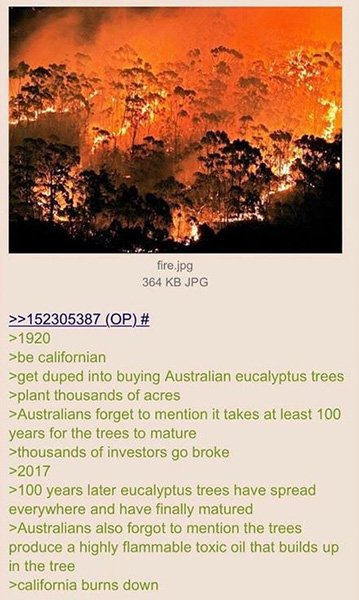Are Australian eucalypts to blame for California’s wildfires?

The question is again being raised as fires rage across Southern California for another year. According to the BBC, approximately 6,700 homes and business have gone up in flames, and further damage is expected as the winds roll in.
Explanations for the wildfires vary, but one myth has persisted: that Australian eucalypts are to blame for California’s wildfires.
The conspiracy reached crescendo last year when a post titled ‘The Great Australian Shitpost, 100 years in the making’ was published on social media platform Reddit, prompting a comprehensive debunk of the tongue-in-cheek accusation by Stefan Kostarelis for Techly, a lifestyle and tech publication.
In the article, Stefan examines the author of the post’s suggestion that Australian eucalypts – introduced to the area, not native – are to blame for the wildfires as the oils they secrete are highly flammable. But he ultimately concludes that the allegations are unanimously false.
Eucalypts in southern California
The author of the Reddit post argued that Australians “duped” Californians into buying Eucalypt seeds back in 1920, which they then planted across thousands of acres.
Rather, a detailed and thoroughly researched piece by Nathan Masters for KCET, argues that eucalypts were first introduced by a single farmer, William Wolfskill, back in 1865.
“William Wolfskill planted five specimens outside his house… An agricultural experimenter who made a fortune growing oranges, walnuts, and wine grapes, Wolfskill must have recognized the eucalyptus’ potential to upset the commercial timber market,” Nathan writes.
After selling his land, another farmer, Ellwood Cooper, renowned for his guidebook Forest Culture and Eucalyptus Trees, planted a 200-acre eucalyptus grove near Santa Barbara in 1872, and more widespread cultivation of the tree across south California began.
Eucalyptus trees take “100 years” to mature?
The other claim the author of the Reddit post made is that, after allegedly duping Southern Californian farmers into purchasing eucalyptus seeds, Australians forgot to mention it would take over 100 years for the tree to fully mature.
Chris Brays, a palaeoclimatologist from Monash University in Melbourne, told Australian Geographic this is incorrect.
“The original claim that it takes 100 years to mature is complete nonsense – one of the main reasons why Eucalyptus plantations are so lucrative is because they grow so damn fast,” he says.
“Their fast growth is also adaptive in the case of fire… when a blaze scorches an area, the trees that can re-grow and capitalise quickly in the disturbed environment will be the ones that survive and flourish.”

Highly flammable eucalypt oils
Chris added that while the oils secreted by eucalyptus trees are highly flammable, one particular study from 2012, published in the International Journal of Forestry Research, showed little difference in fire risk between pines and Eucalyptus in southern USA.
“Introducing select Eucalyptus species into the fire-prone landscape of the southern Coastal Plain raised the spectre of altered fire behaviour and greater risk of destructive wildfire, given the nature of wildfires in Australia where Eucalyptus are native.
“Although there is little empirical information on the fire behaviour in Eucalyptus plantations under the weather conditions found in the southern Coastal Plain, our modelling effort focusing on fire behaviour at the stand level suggests that little may differ from current conditions, given the flammable nature of the native pine species,” the authors concluded.
Another palaeoclimatologist from Melbourne University, Patrick Baker says that the weather, coupled with flammable vegetation, are the likely culprits.
“The problem here is that the weather has been shocking. I was in Ventura two weeks ago and it was 35 degrees [Celcius] in November. The Santa Ana winds that have kicked up have created a perfect storm of flammable vegetation.”
Similarly to Chris, Peter pointed out that Southern California’s native vegetation is flammable in its own right.
“The native vegetation on the hills is very flammable. Intense heat, brutal winds and a spark is all that is needed to start a fire and the whole place will go up in flames,” he says.





